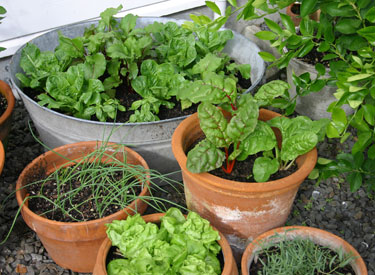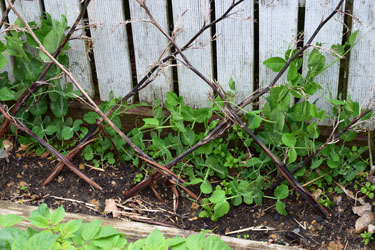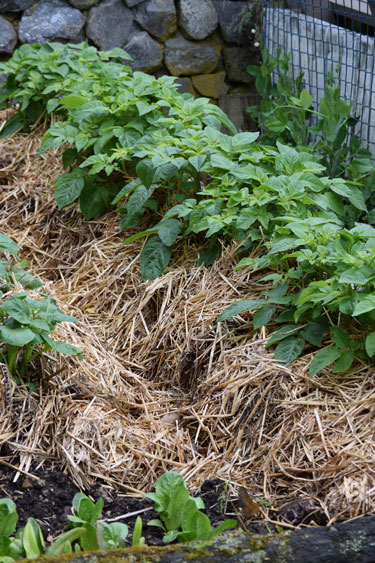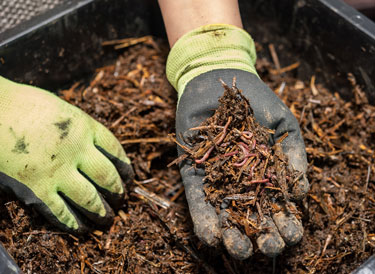Success with Seeds
September has all the hallmarks of spring - blossom, daffodils, new lambs. Nature’s going nuts and gardeners are inspired into action. The planting frenzy begins. But early spring weather is unpredictable. Bright sunny days are interspersed with rainy spells and cold snaps and, in many parts of the country, frosts. Taking advantage of rising temperatures and longer days to get the garden off to an early start must be balanced with caution. Some plants never quite recover from being planted too early into cold soil, so patience pays. Meantime we can prepare the soil get seedlings started in a sunny place indoors or under the protective cover of a greenhouse. By October spring is in full swing although many of us must remain on frost watch until November.
Success with seeds
The sense of satisfaction when harvest time comes is beyond compare!
Seed sowing is not essential to a beautiful productive vegetable garden - expertly grown nursery seedlings are readily available whenever the planting urge is upon us. But the advantages of starting from scratch are a wider choice of varieties, the ability to grow more for your money and of course that wonderful sense of accomplishment. Before you rush into sowing all your seeds, a little forward thinking is wise. Because not all seeds are equal.
Temperature and timing
How long we have to wait for our carefully sown seeds to sprout their first green leaves depends very much on when and where we sow them. It’s all about soil temperature. Each seed variety has its ideal temperature at which germination will occur in the shortest number of days. Tomato seeds for example, will sprout in just six days if the soil (or seed raising mix) exceeds a constant 25°C. At 15°C it takes about two weeks, while at 10°C tomato seeds will take a month or more, if they germinate at all. So there is little point in rushing into sowing certain seeds outdoors in very early spring. On the other hand, a greenhouse with a heating pad will allow you to get a head start. A soil thermometer is another useful tool for keen seed sowers.
Some veges (such as peas, cabbages, radishes and onions) germinate easily at much lower temps, and it makes sense to sow these cool weather veges early to make the most of the spring growing season.
Like tomatoes, capsicum, pumpkins, cucumbers and zucchini need warmer soil temperatures but can be started in pots to be planted outdoors after the risk of frost has passed. The absolute heat lovers are eggplants and melons.
Light
Light is another determining factor for some seeds. Coriander seeds won’t germinate in bright light, nor do pansies and violas. The trick here is to cover the fine seed with a sheet of newspaper or cardboard (or an inverted tray) and remove it after germination. Larger light sensitive seeds, such as sweet peas, can be sown at enough depth to protect them from light. Petunia, impatiens and lettuce are seeds that like the light. Because they are sown on the surface care must be taken to keep these seeds moist. Mist-spray with water regularly or cover with glass or plastic wrap.
Breaking dormancy
Some seeds have built-in protection to protect them from germinating until the time is right. Their preferred wakeup call may be their need to experience low temperatures for a minimum period of time. They may need extra moisture or some form of physical abrasion to break their hard seed coat. If you’re having trouble germinating seeds, check if they have any special requirements.
Spring planting ideas
Garden beds
Planting can start as soon as the soil is dry enough to dig without it sticking to your tools. Where the soil is heavy or the climate is very wet, raised beds are a great way to achieve warmer, better-drained soil.
- Plant out brassica seedlings; broccoli, cabbage, kale, cauliflower into well-prepared soil rich in compost. Brassica plants prefer a higher pH than most, so the addition of lime to ‘sweeten’ the soil can make a big difference to the size and quality of your harvest.
- Go undercover. A tunnel frame is handy when protecting plants from cold and frost. It’s also great for organic pest control. Consider covering your brassicas with insect mesh before the white butterflies appear with warmer weather. Insect mesh is also proving very effective against the tomato and potato pysllid.
- Sow pea seeds directly into well-prepared soil with added compost. Simple teepees made from bamboo stakes make attractive climbing frames for peas.
- Plant herbs for flavour, colour and variety. Perennial herbs such as sage, thyme and rosemary can be cut back for a fresh flush of growth. Plant new parsley plants so they’ll be growing strongly before the old ones go to seed. In warm areas, sow coriander directly into the garden soil. Sow frost-tender herbs such as basil in trays for planting out later.
- Silverbeet can’t be beaten for an easy year-round supply of healthy greens. It grows well in cool conditions and likes plenty of moisture.
- Plant early and main crop potatoes. An assortment of varieties will give you a range of harvest times from Christmas through till autumn.
- Start an asparagus patch. Asparagus is a perennial plant that can be left in the ground to crop for many years, so creating the perfect bed prior to planting is key. Dig a well-drained bed of soil mixing in lots of compost. Asparagus crowns are available for planting in early spring.
- Slugs and snails are out in force in damp weather. Tender young seedlings are prime targets. Be ready with slug bait, or whatever protection you prefer.
- Build the soil. Great growth comes from great soil. Improve soil structure by replenishing its organic matter every spring. Bulky organic fertilisers provide both nutrients and humus. When preparing for planting, avoid digging when the soil is heavy and wet. Too much digging destroys the soil structure.
- Start a compost heap and turn your household and garden waste into black gold for the garden. Compost is the ultimate soil conditioner, enhancing drainage and water holding capacity while empowering plant roots to absorb nutrients. Making your own compost is the most cost effective thing you can do for a healthy thriving vege garden.
- Plant flowers for beneficial insects. Look for herbs and flowers that attract pollinators as well as the predatory insects that will help keep pest populations in check.
Containers
Provided you keep up with watering and feeding, veges grow fast in warm, well-drained container mix. In a sunny sheltered location they’ll suffer less from wind and frost. When your outdoor space is tiny or temporary, growing food in pots is the way to go.
- Plant potatoes in tubs - or buckets or large bags. Fill up the container with planting mix or compost as the plants grow taller and simply tip the container over when it’s time to harvest.
- Grow peas in pots. Choose a large pot or barrel, fill it with container mix. Mix in a handful of sheep pellets. Add a tepee climbing frame and sow your seeds; peas, snow peas or colourful sweet pea flowers.
- Mediterranean herbs thrive in pots. Perennial herbs such as thyme, rosemary and oregano thrive in warm well-drained conditions. Soft herbs such as parsley and basil need regular watering and feeding.
- Salad greens grow easily from seed. Try mini lettuces varieties like ‘Tom Thumb’ and ‘Little Gem’. For the sweetest taste, be sure to keep up with watering and feeding. Rocket grows well in cool weather.
- Sow a weekly batch of microgreens. They’re rich in nutrients and ready to eat within two or three weeks or after sowing. Try tasty fennel, spinach, celery, carrot, peas, beetroot, nasturtium, carrots and radishes, or sow a packet of premixed microgreens seed.
- Make vege pots colourful by mixing flowering annuals with the vege plants. Violas make delightful edging and the flowers are edible.
- Silverbeet makes a very attractive container plant, especially if you grow the colourful ‘Rainbow’ variety.
- Sow carrots in containers at least 30cm deep and then pull out some of the seedlings when they reach 3-5cm tall, allowing about 3cm space between each. As the plants grow, thin them some more and eat the thinnings.
- Spring onions make a great addition to any salad garden. Seedlings are available in garden centres. Or grow them from seed.
- Leeks are fun to grow in containers. Fill the pot to a depth of 20cm of soil, leaving space to add more soil as the leeks grow. To transplant seedlings, make holes with a chopstick, about 6-10cm apart, depending on how fat you want your leeks to grow.
- Fruit to grow in pots includes strawberries, raspberries, citrus, dwarf apples, dwarf peaches, dwarf nectarines, figs, grapes, feijoas, blueberries and olives.
- Start a worm farm. It is a great way to recycle kitchen scraps and produces a ready supply of liquid fertiliser.
Visit www.gogardening.co.nz for more help with vege gardening.

1-Sep-2018

Early veges and herbs growing in pots

Early peas

new asparagus spears

Parsley

Early potatoes

Spring onions

Worms in compost

